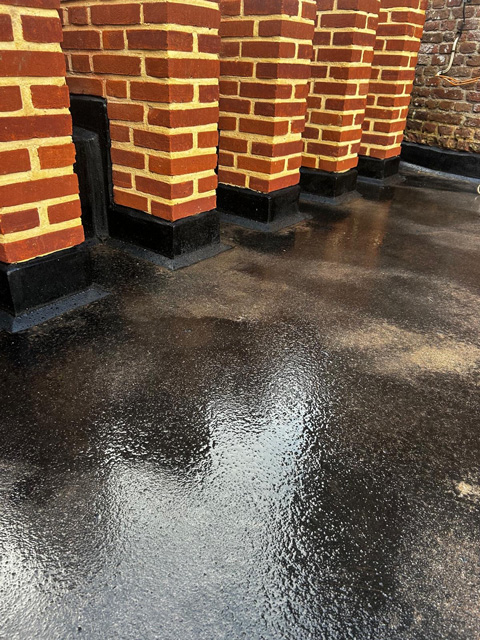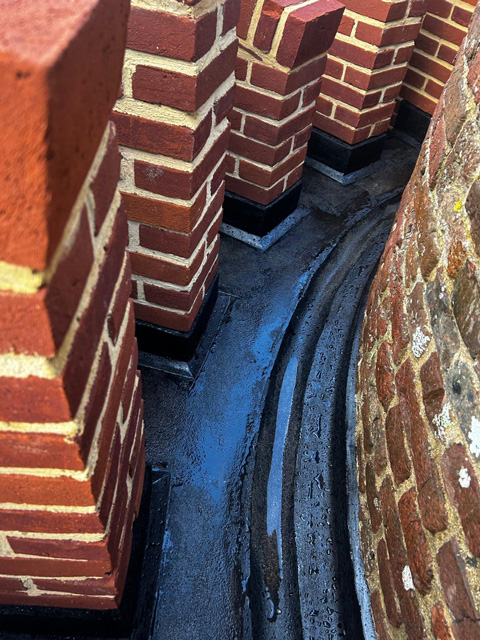Mastic Asphalt Council (MAC) member Sussex Asphalte specialises in the restoration of roofs on buildings of historical significance, so when Herstmonceux Castle in East Sussex required remedial roofing and guttering works, the company was the natural choice for carrying out the works.
 Rich in history dating back to the 15th Century, Herstmonceux Castle is a moated brick castle which is a Grade I Listed Building and a Scheduled Monument recognised on the National Heritage List for England.
Rich in history dating back to the 15th Century, Herstmonceux Castle is a moated brick castle which is a Grade I Listed Building and a Scheduled Monument recognised on the National Heritage List for England.
As one of the earliest brick-built castles in the country, it remains among the oldest significant brick structures still standing today. The site was originally a manor and the name ‘Herstmonceux’ derives from ‘Herst’ (wooded hill) and ‘Monceux’ (a Norman family) who originally held the manor.
It is now a unique visitor attraction with over 600 acres of woodland, wild?ower meadows, and gardens, and also serves as a college and international study centre. Herstmonceux Castle operates as the UK campus of Queen’s University (Canada), which hosts international students every year who come to England to study within the tranquil setting.
Over recent years, significant steps have been taken to ensure the long-term preservation of the historic building and substantial investment has been made in the castle’s infrastructure and facilities.
The castle’s flat roofs, originally protected with mastic asphalt, were showing widespread signs of deterioration. While this traditional system is renowned for its durability – often lasting up to a century – several areas had fallen into serious disrepair, leading to water ingress and damage.
As the castle is a Scheduled Monument, all restoration works needed to be carried out sensitively, demanding the highest levels of craftsmanship and technical expertise in order to preserve the historic fabric.
Adding to the complexity, the gutter works were particularly intricate and difficult to access, and the project uncovered numerous unforeseen issues along the way. This required Sussex Asphalte to adapt quickly to an evolving programme of works, spread intermittently across a six-month period.
Working in close partnership with the main contractor, Valley Builders, Sussex Asphalte carried out multiple phases of repair and renovation. One of the key successes was the restoration of the viewing platform, carefully bringing it back to life in line with the client’s design requirements.
 Mastic asphalt was the natural choice for this project. Not only does it provide unrivalled longevity, it also aligns with traditional construction methods across many heritage sites in England.
Mastic asphalt was the natural choice for this project. Not only does it provide unrivalled longevity, it also aligns with traditional construction methods across many heritage sites in England.
As is the case with many restoration projects, fire safety was a major consideration and mastic asphalt meets all relevant fire standards. By utilising flame-free roofing systems, fire risk from naked flame is eliminated and buildings can remain open and operational during roof refurbishment work.
As mastic asphalt is laid in molten form, it can be confused with other types of waterproofing membrane that require naked flame or torch on application. In reality, there is no naked flame at the point of installation.
The high mineral content of mastic asphalt means that it fulfils all the external fire resistance required for a roof covering and achieves the highest rating (AA) when tested in accordance with BS476 part 3:1975. In addition, mastic asphalt flat roof waterproofing systems from the leading UK manufacturers achieve Fire Classification Broof(t4) in accordance with EN13501-6.
The traditional methods of applying mastic asphalt were used across all areas at Herstmonceux Castle, with fully trained level 3 NVQ operatives present throughout the installation, meaning the client was left with roof areas that should see out the next 100 years at the castle. Finished in heritage grey, the works seamlessly integrated with the building’s character.
The result is a series of roofing and guttering systems that are sympathetic to the castle’s historic fabric. Thanks to Sussex Asphalte’s 75+ years of expertise, Herstmonceux Castle now benefits from durable, heritage-appropriate waterproofing – safeguarding this iconic site for generations to come.
This article featured within the November / December 2025 edition of Roofing Today magazine – click here to view the article.
